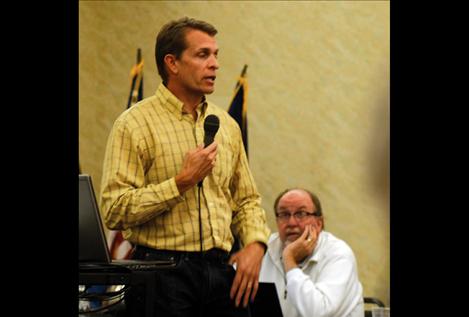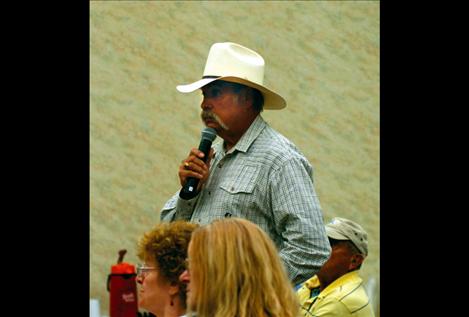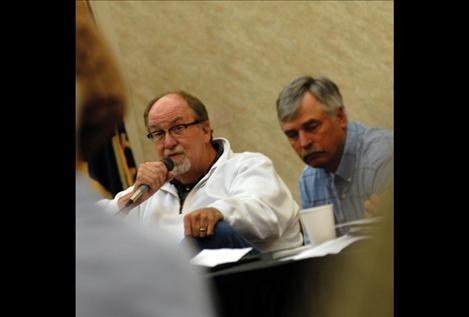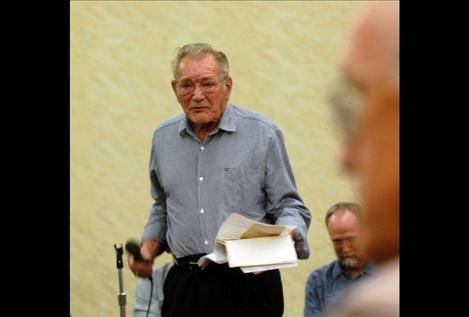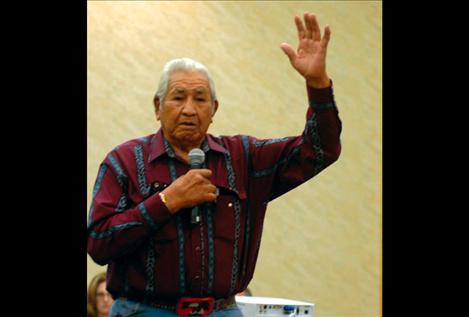Water rights meetings heat up
Hey savvy news reader! Thanks for choosing local.
You are now reading
1 of 3 free articles.
POLSON — With a public meeting on Sept. 4 from 7 to 10:30 p.m. and a negotiating session on Sept. 5 at 9 a.m., water rights were on the front burner at the KwaTuqNuk Resort and Casino last week.
At the evening public meeting, Wade Irion, a professional engineer with DOWL HKM, a regional engineering firm in Billings, again presented information on the technical basis for the Flathead Indian Irrigation Project water use agreement.
Irion’s highly technical presentation showed the water accounting methods that make the reservation-wide water budget, such as accounts for monthly flow for every measurable stream, monthly diversion for every Flathead Indian Irrigation Project and private ditch, ditch losses, crop consumption, reservoir storage, stream seepage losses and gains, etc.
According to Irion, all the elements of the water budget had been independently checked by peer reviewers and technical representatives from all four negotiating teams: the Confederated Salish and Kootenai Tribes, the Flathead Indian Irrigation Project, the state of Montana Reserved Water Rights Compact Commission and the United States.
A crosscheck of the results for crop water use was provided by the METRIC study by Dr. Richard Allen, University of Idaho. The independent study was sponsored by the RWRCC and carried out by Allen and Dr. Jeppe Kjaersgaard.
(To see the entire presentation, go to www.dnrc.mt.gov/rwrcc/ and click on technical basis Confederated Salish and Kootenai Tribes and then under Sept. 4 on technical presentation.)
Bill Greiman, RWRCC agricultural engineer, also talked about the METRIC study. A satellite provides a new image of the Mission Valley every 16 days. The study example averaged evapotranspiration numbers for three dates in 2006, three in 2007 and two in 2008.Evapotranspiration means water going from earth to the atmosphere by evaporating water and transpiration from plants.
Farmers and ranchers in the crowd had doubts about the METRIC study. They also think different areas of the valley need different amounts of water.
Jerry Laskody, a rancher from St. Ignatius, asked how does a snapshot taken at 11 a.m. every 10 days can be used to figure evapotranspiration for the rest of the day and the rest of the year.
Also questioning the study was Dick Erb, Moiese, who had concerns about the small number of observations and the validity of the observations. He’d just finished baling a third cutting of alfalfa so he didn’t think the satellite would pick up any evapotranspiration since his fields were “bone dry.”
“There is a disconnect between how you think farming is done and how farming is actually done,” Erb said.
Retired attorney Lloyd Ingraham had questions for Jon Metropoulos, counsel for the Flathead Joint Board of Control, about irrigators and whether they will lose their water.
A separate negotiation is going on to determine the water use agreement for the Flathead Indian Irrigation Project, which must also fit into the water rights compact. Irrigators will continue to be represented by one of the three irrigation districts and the Flathead Joint Board of Control. The Cooperative Management Entity, which today operates the FIIP and has for three years, will continue Metropoulos said irrigators’ farm turnout allowance is calculated first and then minimum enforceable flow.
He compared MEA and FTA to two bookends. .
“Nobody who negotiates this agreement thinks they are perfect. How those two bookends are met requires flexibility, gathering data and new methods of operation,” Metropoulos said.
Irion also said this project had the most and the best data available, mostly due to the CKST establishing their water management plan.
Area realtor Ric Smith was the only person who spoke in favor of the compact.
“Litigation creates uncertainty,” Smith said, “and business doesn’t like uncertainty.”
He also believes water rights can be decided locally, not by a judge in Washington, D.C.
Other comments and questions came up about who the water actually belongs to, whether the CSKT have jurisdiction over non-tribal residents on the Flathead Reservations, 1855 senior water rights, junior water rights and whether or not the CSKT is a corporation.
Confederated Salish and Kootenai Tribal attorney John Carter explained that Indian tribes in the United States are unique political entities, sovereign nations. The Hellgate Treaty of 1855 has a clause addressing the relationship between foreign nations. The Indian Reorganization Act of 1934 granted additional and further powers, Carter continued. Tribes could, if they chose, incorporate, but that incorporation would not affect land, water and natural resources. Tribes can be a sovereign government and a corporate entity.
Chris Tweeten, chair of the RWRCC, noted that the negotiations are nation to nation since the CSKT are a sovereign nation. Tweeten added that because of the Winters Doctrine of 1908, which provides water for the needs of Native Americans who reside on federally reserved lands, the CSKT are not bound by the state of Montana’s definition of beneficial use.
Also, prior to the Homestead Act of 1910 there was no legal way for non-tribal residents to get a water right on the reservation. Those water rights are junior to tribal water rights, Tweeten said.
RWRCC attorney Jay Wiener said the compact is an attempt by the CSKT, the FJBC, the state of Montana and the United States to protect all water users, irrigators and non-irrigators alike.
(A draft of the proposed compact is available on the state website at www.dnrc.mt.gov/rwrcc/ and on the tribal website at www.cskt.org)
The negotiators hope to agree on the compact and get it in front of the 2013 Montana State Legislature in January. Additional public meetings will be held, and the next negotiating session is scheduled for Wednesday, Oct. 3, at 9 a.m. at the KwaTaqNuk Resort and Casino in Polson.















